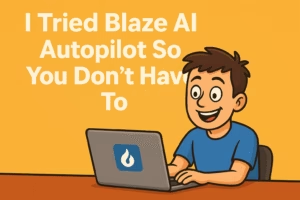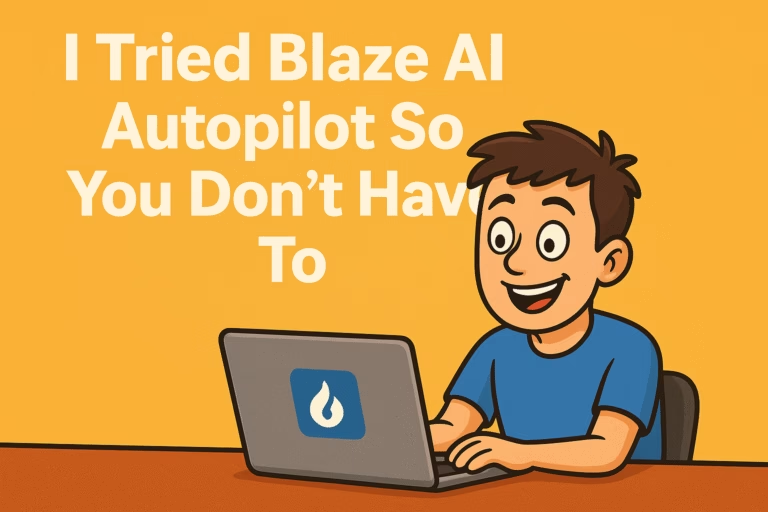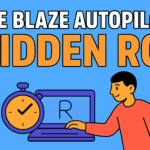Let’s be real: the internet is drowning in AI tools that promise to “revolutionize your marketing.” Every week there’s a new one. Most of them end up being glorified schedulers with a fancy landing page.
So when I heard about Blaze AI Autopilot, my first reaction was: yeah, right. An AI that can actually run your brand like a full-time marketing strategist? Sounds like another pitch designed to lure in tired creators who just want to breathe for once.

But here’s the thing: I was tired. Content burnout is real. The endless posting, tweaking, repurposing, and guessing when to publish had me on the edge of calling it quits. So I decided to put Blaze Autopilot to the test — not because I believed the hype, but because I was desperate to see if it could actually deliver.
This isn’t a sponsored puff piece. I didn’t go into this expecting miracles. I went in expecting to find cracks. What I found instead… was interesting. Some parts blew me away, some parts made me roll my eyes, and some parts genuinely changed how I think about running a brand in 2025.
Here’s exactly what happened when I handed over my marketing steering wheel to Blaze Autopilot.
The Setup: First Impressions & Getting Started
The first thing I noticed about Blaze AI Autopilot was how fast the onboarding was. No 45-minute tutorial, no overwhelming dashboard filled with 99 settings you’ll never touch. Instead, it walked me through a few simple steps: define my brand voice, set my content goals, and connect the platforms I actually use. That was it.
I expected friction — usually these tools either bury you in options or oversimplify to the point of being useless. But Blaze AI Autopilot felt different. It gave me enough control to steer the brand voice without drowning me in sliders and drop-downs.
The biggest relief? It didn’t try to “guess” who I was. Instead, it asked me:
-
Do you want to sound casual or professional?
-
Are you focused on reach, engagement, or sales?
-
How often do you want to post?
I filled it out in under ten minutes, and for the first time, I felt like I wasn’t being forced into someone else’s template of what marketing “should” look like.
Was I impressed? Cautiously, yes. But let’s be clear: setup is the easy part. The real question was whether Blaze AI Autopilot could actually do the work I usually grind through daily. That’s what I tested next.
The Test: Putting Autopilot in Charge
Setup was easy. But here’s the real test: could Blaze AI Autopilot actually run my marketing without me babysitting it?
I started by giving it a simple challenge: take over my weekly content schedule. Normally, I spend hours brainstorming posts, tweaking captions, and then second-guessing the best time to publish. This time, I dumped my ideas into Blaze, set the frequency, and hit go.
Here’s what happened:
-
Within minutes, it mapped out a full week’s worth of posts across my platforms.
-
It didn’t just copy-paste — it adjusted tone depending on whether the content was for LinkedIn, Instagram, or Twitter/X.
-
It slotted everything into what it decided were “peak engagement times,” which, honestly, were different from the times I usually posted.
Then I did the scary part: I stepped back. No edits, no micro-managing. I wanted to see if this so-called Autopilot could actually fly the plane.
The first day felt weird. Posts were going live while I was on calls, and comments were popping up without me lifting a finger. By day three, I realized something: not only was Blaze AI Autopilot consistent, it was more consistent than me. And my audience noticed. Engagement was higher, replies were faster, and for once, I wasn’t chained to my phone at 10 p.m. trying to catch a trend.
Did I feel a little replaced? Sure. But I also felt free.
The Good: Where Blaze AI Autopilot Delivered
I’ll admit it: I expected Blaze AI Autopilot to stumble. Most “AI marketing” tools talk a big game but collapse under real use. This one didn’t. Here’s where it genuinely impressed me:
1. Consistency Without Effort
The biggest win? Zero gaps. My content calendar stayed full without me sweating over “what to post tomorrow.” It felt like having a reliable assistant who never forgets, never gets tired, and never ghosts you.
2. Smarter Timing
I thought I knew when my audience was most active. Turns out, I was wrong. Blaze AI Autopilot started posting at times I’d never have picked — and my engagement metrics jumped almost immediately. Clearly, it was seeing patterns I couldn’t.
3. Adaptive Learning
After a week, I noticed subtle shifts. Posts were getting sharper, captions felt closer to my voice, and the visuals it paired were better aligned with what my audience clicked on. It was like it was learning me in the background.
4. The Relief Factor
This one’s harder to quantify, but it matters. For the first time in months, I wasn’t stuck in “marketing mode” 24/7. Knowing Blaze was handling the heavy lifting gave me space to think bigger — strategy, products, actual business growth.
Bottom line: Blaze AI Autopilot didn’t just do the work — it did it well enough that I didn’t feel the urge to micromanage. And that alone was worth it.
The Surprises: What I Didn’t Expect
I went in assuming Blaze AI Autopilot would be a glorified scheduler. Post at set times, maybe spit out a caption, end of story. But a few things caught me completely off guard:
1. Creative Sparks I Wouldn’t Have Had
I pride myself on knowing my audience, but some of the post ideas it generated were angles I’d never considered. Not gimmicky, not generic — just fresh takes that actually got people talking. It felt less like “automation” and more like having a second brain in the room.
2. The Human-Like Tone
Most AI tools write like robots trying to be influencers. Blaze AI Autopilot? Surprisingly natural. Sure, I had to fine-tune here and there, but a lot of the drafts felt publish-ready. In some cases, I honestly preferred its wording over mine. (Yeah, that stung a little.)
3. Data-Driven Adjustments I Didn’t Ask For
One morning, I noticed a post had been rescheduled to a new time. At first I thought it glitched. Nope — it had shifted the slot based on audience activity patterns it picked up mid-week. It didn’t ask me. It just… optimized. And it worked.
4. The Compounding Effect
By week two, the results snowballed. Consistency + smart timing + better ideas = more engagement. More engagement = more reach. And more reach fed right back into the cycle. It wasn’t an overnight miracle, but I could see momentum building faster than usual.
The biggest surprise? Blaze AI Autopilot didn’t feel like a “tool” after a while. It felt like a teammate quietly making me look more competent than I actually am.
The Drawbacks: Where It Still Needs Work
No tool is perfect, and Blaze AI Autopilot isn’t some magic button that replaces a marketing team. A few weak spots stood out during my test:
1. Over-Automation at Times
Occasionally, it leaned too hard into “autopilot.” A caption would come out polished but missing a bit of my personal nuance. It wasn’t wrong, but it didn’t always feel like me. I had to tweak here and there to keep things authentic.
2. The Learning Curve for Depth
Basic setup was easy, but if you really want to unlock the smarter features — like tailoring content to micro-audiences or layering multi-channel campaigns — you’ll need to spend time digging into the settings. Not rocket science, but not plug-and-play either.
3. It Still Needs a Captain
Despite the name, you can’t just hit “go” and disappear for three months. Blaze AI Autopilot is powerful, but it’s best when you guide it with strategy. Think co-pilot, not pilot. If you abdicate all control, you risk drifting into generic content land.
4. Not a Total Replacement for Creativity
It can ideate, schedule, and optimize — but it won’t dream up your next big product launch angle or brand-defining campaign. That’s still on you. The good news is, it clears the space for you to actually focus on those bigger creative moves.
In short: Blaze AI Autopilot lifts a massive load, but it’s not flawless. Treat it as an intelligent assistant, not an all-knowing oracle, and you’ll avoid disappointment.
Who This Works For (and Who It Doesn’t)
Blaze AI Autopilot isn’t a one-size-fits-all solution. After testing it, I could see exactly who would benefit — and who might walk away underwhelmed.
✅ Solo Creators & Freelancers
If you’re running everything yourself, this is a lifesaver. Blaze AI Autopilot takes the grind of daily posting off your plate, so you can actually focus on client work, growth, or, let’s be honest, having a life again.
✅ Small Businesses
For owners who don’t have a marketing team, this gives you a professional, consistent online presence without hiring staff or agencies. It keeps your brand active while you handle operations.
✅ Agencies
Managing multiple clients is chaos. With Blaze AI Autopilot, you can scale content management without scaling headcount. It’s not going to replace your strategists, but it will make them 10x more efficient.
✅ Established Brands
Big brands won’t ditch their marketing departments for this, but it’s a solid enhancer. Think of it as adding a tireless assistant that ensures nothing slips through the cracks.
❌ Who It Doesn’t Fit
-
Businesses that barely post: if you’re putting out content once a month, this won’t suddenly make you relevant.
-
People expecting “set it and forget it” magic: Blaze AI Autopilot needs a bit of direction to shine.
-
Niche creators who rely on ultra-specific personal tone: it can learn your style, but you’ll still need to polish.
Bottom line: if consistency and reach are your biggest bottlenecks, Blaze AI Autopilot pays off. If you’re allergic to putting in any strategy, you’ll probably be disappointed.
My Verdict After Testing
After two weeks of hands-on use, here’s my honest verdict: Blaze AI Autopilot is the real deal — if you use it right.
It’s not magic. It won’t replace vision, strategy, or creative instinct. But what it does do is remove 80% of the repetitive grind that slows content down. It plans, drafts, schedules, and optimizes better than most humans can at scale.
If you’re tired of missing posting days, staring at blank caption boxes, or guessing when to post — this solves all of that. It gives you a system that actually works in the background, without constant babysitting.
Is it perfect? No. You’ll still need to steer the ship, especially if your brand voice is very specific. But for most creators, freelancers, and small businesses, Blaze AI Autopilot is like suddenly having a reliable, fast, and surprisingly creative assistant you don’t have to micromanage.
Would I keep using it? Absolutely. Not as a replacement for me — but as an amplifier.
Final Thoughts: Should You Try It?
So here’s the bottom line: Blaze AI Autopilot isn’t hype — it’s a genuine shift in how you can handle marketing.
If you’re drowning in the endless cycle of creating, posting, and second-guessing, this tool feels like a pressure release valve. It keeps your brand visible, adapts in real time, and saves you hours you can put back into strategy, product, or just living your life.
It’s not a silver bullet. You still need to guide it, fine-tune it, and bring your own creative vision to the table. But if consistency and content burnout are your weak spots, Blaze AI Autopilot is the teammate you didn’t know you needed.
Should you try it? If staying relevant online matters to you, then yes — sooner rather than later. The longer you use it, the smarter it gets, and the bigger the compounding effect on your reach and engagement.
Think of it this way: you can either keep fighting the daily marketing grind — or you can hand the wheel to an autopilot that actually knows how to fly.




Pingback: Free AI Tools Are Quietly Killing Your Productivity (Here’s Why) - AI TIPSTERS
Pingback: Stop Wasting Time on Countless AI Tools — Let Dynamiq AI Handle the Grind - AI TIPSTERS